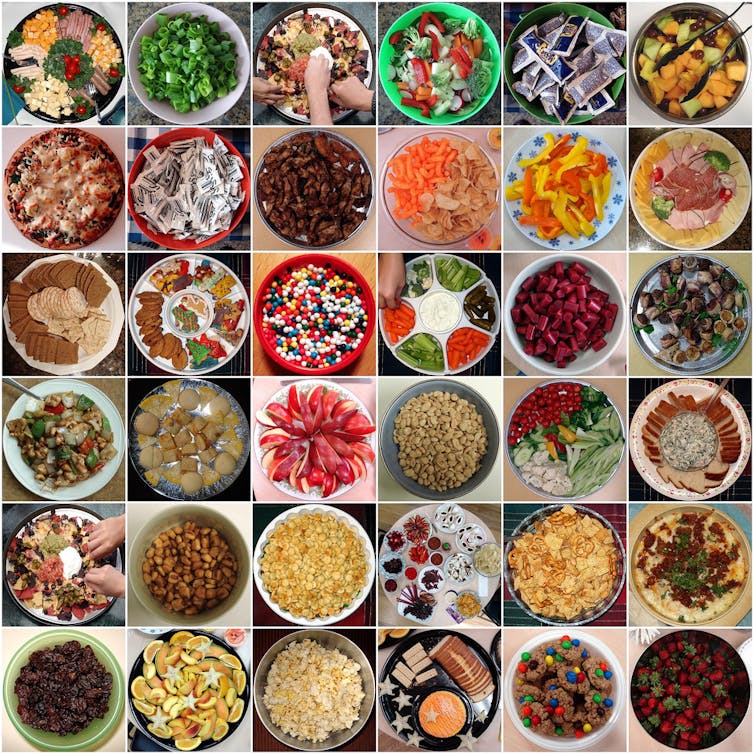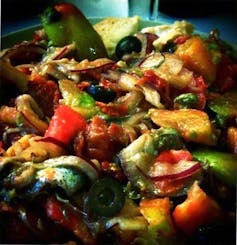Dietary guidelines cite the fact that saturated fats can increase LDL cholesterol, which is also known as bad cholesterol because it’s a major risk factor for heart disease. Others claim saturated fats are not a problem.
So is saturated fat a saint or sinner? Or could the search for a single culprit miss the inevitable subtleties of a multifactorial problem such as heart disease?
These are complex questions so let’s start with what cholesterol and fats actually are and the different types.
Cholesterol is a waxy substance found only in animal products. It’s an essential component of our bodies, easily made within the body. A diet high in particular saturated fatty acids can increase cholesterol production, assisted by genetic factors, to levels that dramatically increase the risk of heart attacks.
Fats in food
The fats in food are categorised on the basis of their chemical structure as saturated, monounsaturated or polyunsaturated. Polyunsaturated fatty acids are further divided into omega 3s and omega 6s (here’s a more detailed description).
Individual foods are defined by the major type of fatty acid they contain. So olive oil is tagged “monounsaturated” although 16% of its fatty acids are saturated and 9% are polyunsaturated.
A “polyunsaturated” margarine spread may have 45% polyunsaturated fatty acids, 30% monounsaturated and 25% saturated. That’s less than the 70% saturated fat content of butter, but it’s not an insignificant amount by any means!
Fats in blood
Being insoluble in liquid, fats and cholesterol are carried in the blood in protein-fat compounds (called lipoproteins) that vary in their density and function.
Low-density lipoproteins (LDL) carry cholesterol from the liver and can deposit it in plaque on the walls of the coronary (and other) arteries. This can restrict blood flow and, aided by inflammatory reactions, plaque can block an artery causing heart attack or stroke.

That’s why LDL cholesterol is often tagged as “bad” (high LDL levels may also be responsible for erectile problems in men). LDL cholesterol can also bind to another heart disease risk protein called apolipoprotein(a) or Lp(a).
High-density lipoproteins (HDL) carry stray bits of cholesterol back to the liver for disposal and are therefore “good”. The ratio of total to HDL cholesterol to LDL cholesterol now appears to give a stronger correlation with heart disease than LDL levels on their own.
Triglycerides are the form of fat circulating in the blood immediately after meals that are available to cells for energy and likely to be used during physical activity. Any excess, which can come from too much ingested fat, carbohydrate or alcohol, is stored as body fat.
High triglyceride levels frequently accompany high LDL, low HDL and upper body fat. The omega 3 fats found in fish may help lower triglycerides.
Types of saturated fat
Of the many saturated fatty acids in foods, three (myristic acid, palmitic acid and lauric acid) have the greatest effect in raising blood cholesterol.
Large quantities of shorter chain fatty acids (especially caprylic and capric found in foods such as butter, goat and cow’s milk cheeses, and coconut) can increase triglyceride levels.
Some saturated fatty acids such as stearic acid (in meat fat and chocolate) can increase triglyceride levels, but have no effect on blood cholesterol.
Lauric acid, one of the major fatty acids in coconut oil, may raise both LDL and HDL. This makes it less “bad” than its total saturated fat implies. Still, while coconut oil may be better for LDL blood cholesterol than butter, it’s not as good as liquid oils, such as safflower oil.
All this may sound a little complicated (and it is) but there’s something simpler at the heart of the issue that’s much more important.
Foods vs nutrients
Claims that saturated or unsaturated fats are “good” or “bad” are distorted by ignoring their food sources.

Consider that the same quantity of saturated fat is found in 35 grams of cheese, 35 grams of white chocolate, 70 grams of potato crisps, 90 grams of roasted cashews, a small (145 grams) rump steak, a tablespoon of lard, 50 grams of polyunsaturated margarine, a small custard tart and 15 grams of hollandaise sauce!
The same goes for other fats. Monounsaturated fats, for instance, are the dominant type of fat in chicken noodle soup, eggs, peanut oil, avocado, liquorice, almonds, rolled oats, chocolate chip muesli bars and chicken nuggets.
It would clearly be a nonsense to assume these foods were nutritionally equivalent, but judging only their content of saturated or monounsaturated fat creates that absurdity.
Early studies using liquid oils added to a standard diet reported that unsaturated fatty acids lowered blood cholesterol.
In Mediterranean populations, most unsaturated fats come from olive oil and nuts – foods with wide range of other beneficial components. But in North America and Australia, major sources of unsaturated fats include products such as frying oils and spreads.
Until fairly recently, spreads were made by partially hydrogenating (adding hydrogen atoms to) liquid oils. The same process was used for oils for commercial frying, snack foods, confectionery, pastries, biscuits and crackers and anything with a crisp coating.
It took scientists years to realise that partial hydrogenation produces an unsaturated, but nasty trans fatty acid called elaidic acid. This fat raises LDL cholesterol, lowers HDL cholesterol, increases inflammation and has a string of other undesirable effects.

Other processes are now used to make spreads, but we have no way of identifying other foods with elaidic acid as it need not be labelled in Australia. It was recently found in margarine sold in remote communities.
Saint or sinner?
Going back to the question we started with, whether saturated fat is a saint or sinner depends on the quantity consumed and on other features of the food containing it.
One oft-quoted review of observational studies concluded there was no association between saturated fat and heart disease.
But one of the authors of the paper is supported by Unilever and two are “supported by the National Dairy Council”, so there are clear conflicts of interest involved. One also receives support from the National Cattlemen’s Beef Association.
What’s more, major flaws in the study’s methodology have been pointed out.
Food companies complicated matters by producing many low-fat foods with sugar and refined starches replacing fat. This has been counterproductive although randomised controlled trials have established strong evidence of benefit by substituting unsaturated fats, especially those from seafood.
The fact is, the diversity of foods containing saturated and unsaturated fats in modern diets is a major source of confusion. A simple way through the muddle is to follow dietary patterns associated with low levels of heart disease and other health problems. This also helps avoid the absurdity created by thinking in terms of individual nutrients rather then whole foods.
My bias is for Mediterranean dietary patterns that favour few highly processed junk foods, cheese and yoghurt rather than butter and only modest meat intake.
The basis of the day’s meals includes a variety of fruits, vegetables, legumes, nuts and grains, with extra virgin olive oil, herbs and spices. Foods high in butter or sugar are enjoyed on special occasions. It’s an enjoyable and proven healthy way to eat.

